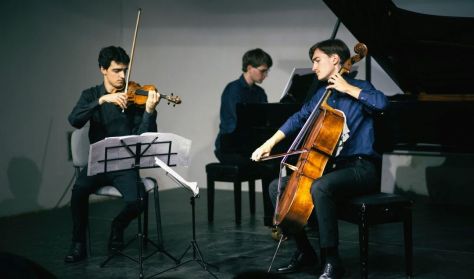
Ránki - Stark - Devich: Zongoratriók
After four concerts in 2023, János Mátyás Stark, Gergely Devich and Fülöp Ránki are announcing a
new series at the BMC, now under the name of Trio Haris.


After four concerts in 2023, János Mátyás Stark, Gergely Devich and Fülöp Ránki are announcing a
new series at the BMC, now under the name of Trio Haris.
5 October 2024 – Trio Haris (Ránki – Stark – Devich) I. | Haydn, Liszt, Schubert
The trio’s first concert will feature two special gems before the well-known closing piece. Haydn';s
Trio in E-flat Minor is special not only for its unusual tone and the quasi-amalgam form of its first
movement: its second movement was originally called "Jacob's Dream" by the composer, who jokingly
composed the biblical ladder leading from earth to heaven into the heights of the violin part – for an amateur violinist who was notoriously at odds with such positions. Liszt's chamber music output is a small slice of his vast oeuvre as a composer, and these works are very rarely heard. Tristia is a late trio version of the piano work Obermann's Valley, which lacks the dramatic recitative and glowing final section of the original piano version; Liszt retained only the melancholic first movement, thus referring the piece into the realm of his purely contemplative late works. The evening concludes with Schubert's Trio in E-flat major, one of the evergreen jewels of the immense wealth of Austro-German chamber music.
4 January 2025 – Trio Haris (Ránki – Stark – Devich) II. | Takemitsu, Schubert, Shostakovich
The second concert will be dedicated to Shostakovich and Takemitsu, also featuring a piece by Schubert. The two piano trios by Shostakovich range from unravelling to resignation. He wrote his Trio No 1 in C minor when he was sixteen and dedicated it to his girlfriend. Its single movement is bold and mature, although still closely linked to Romanticism. It is preceded by Toru Takemitsu's late trio Between Tides. The piece's contemplative, almost meditative character and subtle sonorities contrast sharply with the rest of the programme's rather narrative pieces. The second half opens with Schubert's Notturno, whose intimate tone is punctuated by solemn episodes. The Trio No 2 in E minor, completed in 1944, was dedicated by Shostakovich to the memory of his friend Ivan Shollertinsky, who died young. The scherzo, with its bursting energy, is surrounded by three sombre movements in a serious tone, creating an unforgettable atmosphere. The tragic return of the first movement';s theme before the finale's end seems to be a reference to Tchaikovsky's Trio in A minor, also in memory of a lost friend.
22 March 2025 – Trio Haris (Ránki – Stark – Devich) III. | Haydn and Beethoven
The third concert will feature two of the classical giants of the piano trio genre, Haydn and Beethoven. Haydn, as in so many of his works, is making countless subtle jokes in his Trio in E major. Even the string pizzicatos of the main theme at the very beginning of the piece are not out of the ordinary, not to mention the long piano solo in the slow movement and the sometimes breakneck modulations. The work's majesty and loftiness make it an ideal counterpart to Beethoven's "Archduke" Trio – although their character makes it evident that while Haydn dedicated his trio to a virtuoso pianist, Beethoven's piece is addressed to Archduke Rudolf of Habsburg-Lorraine, to whom the composer dedicated many of his compositions. One of the most large-scale works in the trio repertoire, it is symphonic in scale yet retains the softness of the B flat major tonality and the the intimacy so characteristic of a small chamber ensemble, and its Andante in D major is one of Beethoven';s most touching slow variational movements.
7 June 2025 – Trio Haris (Ránki – Stark – Devich) IV. | Schumann and Brahms
The series will conclude with works by two closely related geniuses of romantic chamber music. The
professional and personal relationship between Schumann and Brahms has a wealth of musical and non-musical sources, and a vast literature. Both wrote three piano trios, the first of which will be performed in this concert. Schumann wrote his first trio in D minor (Op. 63) relatively late, and its troubled D minor, passing through the lively F major of the scherzo and the dark A minor of the slow movement, finally resolves into the luminous D major of the finale. Brahms's Trio in B flat major bears the opus number 8 – the composer wrote the first version in 1854, when he was twenty-one –, but this is misleading because it was thoroughly revised three and a half decades later. Dramaturgically, the work is essentially the reverse of Schumann's, and, uniquely among the top works of the trio repertoire, begins in a major key but ends in minor.
item(s) in basket
total:
Time limit has expired. Please, put item(s) in to basket again.